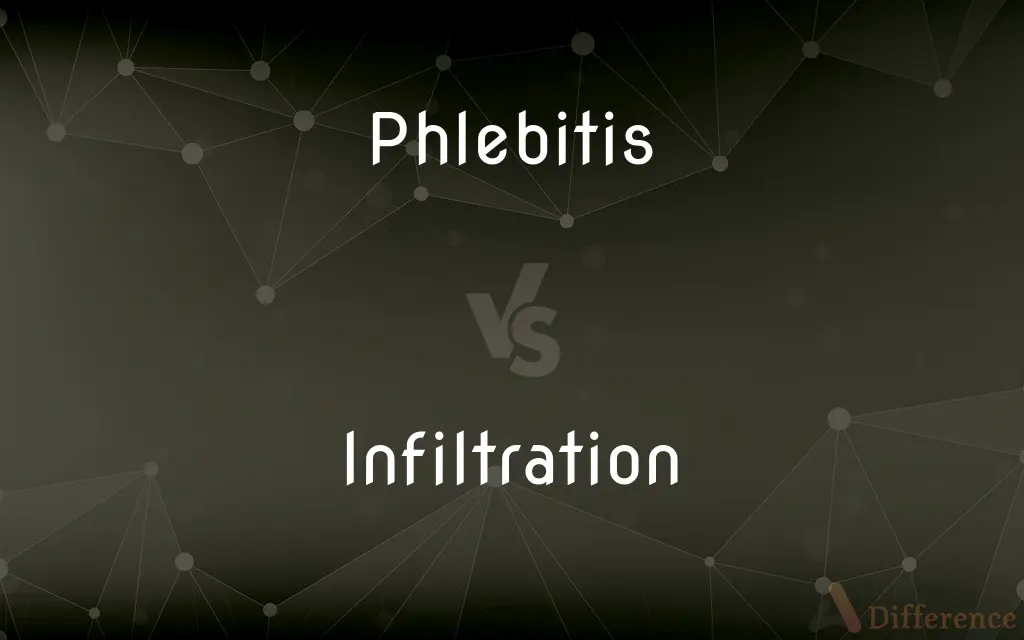Phlebitis vs. Infiltration — What's the Difference?
By Urooj Arif & Maham Liaqat — Updated on May 13, 2024
Phlebitis refers to inflammation of a vein, often associated with a thrombus (blood clot), whereas infiltration involves the unintended leakage of non-vesicant fluids into surrounding tissues from an intravenous (IV) site.

Difference Between Phlebitis and Infiltration
Table of Contents
ADVERTISEMENT
Key Differences
Phlebitis manifests as vein inflammation, which may result from an IV catheter, trauma, or infection, leading to redness, swelling, and pain along the vein. Infiltration, on the other hand, occurs when IV fluids enter the surrounding tissue rather than the vein, causing swelling, discomfort, and possible tissue damage.
The causes of phlebitis can include mechanical irritation from a vein catheter, chemical irritation from medication, or infection. In contrast, infiltration is typically caused by the dislodgment of an IV catheter or puncture of the vein wall, allowing fluids to escape into the tissue.
Treatment for phlebitis often involves removing the IV line if present, applying heat to the affected area, and possibly using anti-inflammatory medications or antibiotics in cases of infection. Treatment for infiltration also includes removing the IV line, along with elevating the affected limb and applying cold compresses initially followed by warm compresses to reduce swelling.
Phlebitis can lead to more serious conditions such as deep vein thrombosis if not treated properly. While infiltration generally resolves with proper care, severe cases can result in complications like compartment syndrome if a large volume of fluid accumulates.
Monitoring techniques differ significantly; phlebitis requires assessment of vein hardness, tenderness, and signs of infection, whereas infiltration necessitates frequent checks for swelling, coolness, and pallor at the IV site.
ADVERTISEMENT
Comparison Chart
Definition
Inflammation of a vein.
Leakage of IV fluids into surrounding tissue.
Causes
IV catheters, trauma, infection.
Dislodgement of IV, vein puncture.
Symptoms
Redness, swelling, pain.
Swelling, discomfort, coolness at the site.
Treatment
Remove IV, apply heat, medications.
Remove IV, elevate limb, apply cold then warm compresses.
Potential Complications
Deep vein thrombosis.
Compartment syndrome, tissue damage.
Compare with Definitions
Phlebitis
Inflammation of a vein, often accompanied by pain and swelling.
The patient developed phlebitis at the site of the IV catheter, requiring medical intervention.
Infiltration
An IV complication where fluid unintentionally enters tissue, causing swelling and discomfort.
Infiltration was suspected when the patient complained of pain around the IV site, which felt unusually puffy and cool.
Phlebitis
A medical condition characterized by a vein becoming inflamed due to infection, irritation, or injury.
After the long flight, she experienced phlebitis in her lower leg, highlighting the need for periodic movement.
Infiltration
A common issue in IV therapy where fluid escapes from the vein to the surrounding area.
Regular monitoring for signs of infiltration, like tissue swelling, is essential in IV care.
Phlebitis
The occurrence of vein inflammation that may result in redness and heat along the affected vein.
To treat the phlebitis, the doctor recommended warm compresses and anti-inflammatory medication.
Infiltration
Occurs when IV fluids leak into the surrounding tissues instead of the vein.
The nurse identified infiltration early, noting the swelling and coolness around the IV site.
Phlebitis
A vascular disorder that can result from mechanical or chemical irritation.
Chemical phlebitis was diagnosed after the patient reacted to the medication infused through the IV.
Infiltration
An unintended leakage that can lead to tissue damage if not addressed.
Severe infiltration required surgical intervention to relieve pressure in the affected tissue.
Phlebitis
A condition where veins swell due to inflammation, potentially leading to thrombosis.
The nurse assessed the patient for signs of phlebitis, such as tenderness and red streaks.
Infiltration
The inadvertent administration of non-vesicant fluids into subcutaneous tissue.
To manage the infiltration, the healthcare team removed the IV and applied a cold compress.
Phlebitis
Phlebitis or venitis is the inflammation of a vein, usually in the legs. It most commonly occurs in superficial veins.
Infiltration
The act or process of infiltrating.
Phlebitis
Inflammation of the walls of a vein.
Infiltration
The state of being infiltrated.
Phlebitis
Inflammation of a vein.
Infiltration
Something that infiltrates.
Phlebitis
(pathology) Inflammation of a vein, usually in the legs.
Infiltration
The act or process of infiltrating, as of water into a porous substance, or of a fluid into the cells of an organ or part of the body.
Phlebitis
Inflammation of a vein.
Infiltration
Process by which water on the ground surface enters the soil.
Phlebitis
Inflammation of a vein (usually in the legs)
Infiltration
The substance which has entered the pores or cavities of a body.
Infiltration
The act of secretly entering a physical location and/or organization.
Infiltration
The act or process of infiltrating, as of water into a porous substance, of a fluid into the cells of an organ or part of the body, or of persons into a hostile organization.
Infiltration
The substance which has entered the pores or cavities of a body.
Calcareous infiltrations filling the cavities.
Infiltration
A process in which individuals (or small groups) penetrate an area (especially the military penetration of enemy positions without detection)
Infiltration
The slow passage of a liquid through a filtering medium;
The percolation of rainwater through the soil
The infiltration of seawater through the lava
Common Curiosities
What are the risks associated with untreated phlebitis?
Untreated phlebitis can progress to deep vein thrombosis, a serious condition that can lead to pulmonary embolism.
What are the key signs of phlebitis?
Key signs include tenderness, warmth, redness, and sometimes a palpable cord along the vein.
Can both phlebitis and infiltration occur at the same IV site?
Yes, it's possible for a patient to develop phlebitis at an IV site initially, which could then also become infiltrated if the IV catheter dislodges.
Is phlebitis always associated with IV therapy?
Not always; phlebitis can also result from trauma or infection independent of IV therapy.
Are there long-term effects of severe infiltration?
Severe cases can lead to tissue damage and, rarely, complications like compartment syndrome, which might require surgical intervention.
What distinguishes phlebitis from infiltration?
Phlebitis is the inflammation of a vein, possibly with a clot, whereas infiltration involves fluid leaking into the surrounding tissue.
What should be done if phlebitis or infiltration is suspected?
The IV should be removed, and appropriate treatments should be administered based on the specific condition.
How should infiltration be treated?
Treatment involves removing the IV, elevating the affected area, and applying cold followed by warm compresses to reduce swelling.
How can infiltration be prevented?
Proper IV insertion techniques, securement, and regular monitoring of the IV site are crucial to prevent infiltration.
Can phlebitis be treated at home?
Mild cases might be manageable with home care, such as warm compresses and over-the-counter anti-inflammatory drugs, but medical advice is recommended.
Share Your Discovery

Previous Comparison
Republican vs. Democrat
Next Comparison
Commitment vs. AgreementAuthor Spotlight
Written by
Urooj ArifUrooj is a skilled content writer at Ask Difference, known for her exceptional ability to simplify complex topics into engaging and informative content. With a passion for research and a flair for clear, concise writing, she consistently delivers articles that resonate with our diverse audience.
Co-written by
Maham Liaqat












































